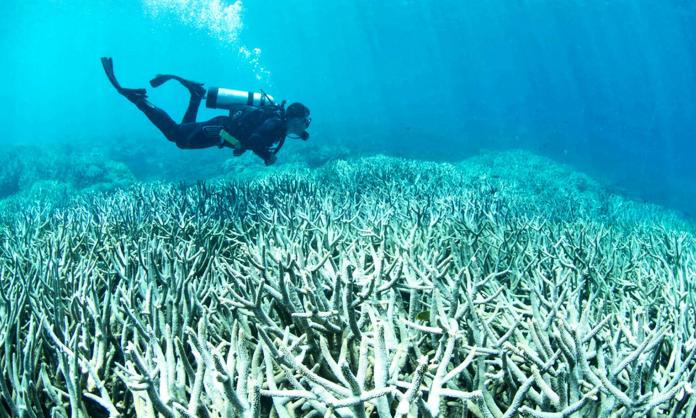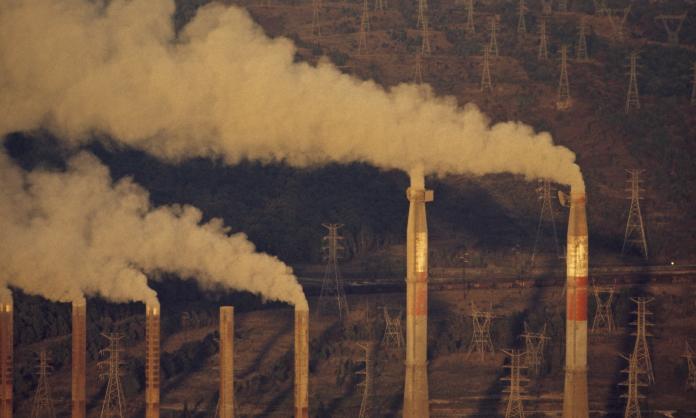Our ecosystem, and the very possibility of much life, depend on the stability of the ocean. Half or more of the atmosphere’s breathable oxygen comes from phytoplankton and other marine plants. For that reason alone, if the ocean’s natural systems were to be seriously destabilised, it would be catastrophic both for the planet and for human civilisation. The most known aspect of the oceanic crisis is the melting of the polar ice caps and the corresponding rise in global sea levels. New estimates by British scientists suggest that, between 1994 and 2017, the Earth lost 28 trillion tonnes of ice. The rate of ice loss is accelerating, having climbed by 57 percent since the 1990s. And this acceleration is set to continue, as the Arctic is warming at a faster rate than the rest of the world.
For now, the greatest contributor to rising sea levels is the melting of the Greenland ice sheet. Recent research published in Communications Earth & Environment, a scientific journal, suggests that the ice sheet has entered “a new dynamic state of sustained mass loss”. With snowfall insufficient to replenish melted ice, a regional feedback loop has begun. Even a reversal of global temperature rises will not stop the ice’s disappearance. If the ice sheet were to melt entirely, global sea levels would rise by 7.2 metres. In coming decades, rising sea levels will radically reshape the world’s coastlines. Major coastal cities will face catastrophic flooding. Greater Jakarta, the capital of Indonesia and home to almost 36 million people, provides a glimpse of where we could be heading. While bushfires were ravaging Australia on 1 January 2020, Jakarta was lashed by storms that brought 400 millimetres of rain in just a few hours. In the resulting flooding, made worse by 40 percent of the city’s land area lying below sea level, 66 people were reported dead from drowning, hypothermia, landslides and electrocution.
In disasters like these, it’s inevitably the poorest areas that suffer most. The rich have the means to protect themselves from the elements. In the case of Indonesia, the inequality is illustrated by the government’s proposal to build a new capital in Kalimantan (Borneo). From there, the government presumably would continue to promote the fossil fuel industry and other environmentally destructive practices while Jakarta is further swamped by the ocean.
Unfortunately, rising sea levels are just one problem among many. The ocean is also undergoing a disturbing chemical transformation caused by and reinforcing climate change. Nicholas Gruber, ETH (Federal Institute of Technology) Zurich professor of environmental physics and an authority in the field of ocean chemistry, has long called attention to three factors—what he calls “the triple whammy”—driving long-term change: acidification, warming and deoxygenation. These processes, as Gruber warned in 2011, “are essentially irreversible on centennial time scales”.
Ocean acidification is a direct consequence of human-caused carbon emissions. A relatively balanced transfer of carbon dioxide molecules between the ocean and the atmosphere has been disrupted by the excessive amounts of carbon dioxide entering the atmosphere since the industrial revolution, forcing the ocean to absorb both a larger proportion of the gas as well as trapped solar heat. The ocean’s absorptive role has temporarily and partially stabilised the atmosphere and spared us from more extreme temperatures in the short term. But the ocean can take only so much. Carbon dioxide, when dissolved in water, makes carbonic acid. The more carbon dioxide is absorbed, the more acidic the ocean becomes.
This reaction, already sapping the life from coral reefs, threatens to undermine the very basis of marine ecosystems. Organisms at the bottom of the food chain, like phytoplankton, will struggle to grow their cell walls, increasing their mortality. Dependent species, everything from whales to anchovies, will begin dying from starvation. Ian Angus, editor of the journal Climate and Capitalism, explains that increasing acidity “has already significantly changed the habitats that marine plants and animals depend on: a further reduction could be deadly for many of them”. The threat of acidification is now widely recognised by scientists, with the generally conservative Intergovernmental Panel on Climate Change reporting in 2019 that “it is very likely that over 95 percent of the near surface open ocean has already been affected”.
Today, ocean temperatures are also rising rapidly, a result of absorbing 90 percent of excess heat created by the greenhouse effect. A study by a team of fourteen scientists from around the world, published in Advances in Atmospheric Sciences in January, found that in 2019 the ocean’s heat content was 228 sextillion joules above the 1981-2010 average. “That’s a lot of zeros indeed”, the study’s lead author, Lijing Cheng of the Institute of Atmospheric Physics in Beijing, explained. “The amount of heat we have put in the world’s oceans in the past 25 years equals 3.6 billion Hiroshima atom-bomb explosions.”
Marine biodiversity in tropical regions is collapsing under the pressure of this warming as fish migrate to the poles and immobile organisms die—like the coral in Australia’s Great Barrier Reef. Extreme heatwaves over the Pacific Ocean are now a regular fixture. Warmer water also encourages the formation of cyclones, which scientists predict will become more frequent and intense.
Rising temperatures have also helped trigger the most terrifying aspect of the marine crisis: ocean deoxygenation. Warmer waters hold less oxygen. The living part of the ocean is being slowly suffocated. We can never build a ventilator to support it. Since the Second World War, the ocean’s oxygen content has declined by around 2 percent. This may seem like a small number. But in the same way that a global temperature rise of two degrees Celsius threatens climate catastrophe, a 2 percent oxygen loss has thrown the ocean dramatically out of balance. Deoxygenation does not spread evenly. Instead, it manifests in the formation of “dead zones”—territories of seawater with such low oxygen content that very few organisms can survive there. These dead zones tend to develop near coastlines, the areas where most marine habitats are located.
The other major contributor to deoxygenation is the nutrient discharge from industrial agriculture. The profits of agribusiness rely on the widespread use of synthetic chemical fertilisers. The nitrogen waste from megafarms is carried by rivers into the sea, promoting algal blooms. These consume surface oxygen, reducing how much oxygen sinks downwards. As the International Union for Conservation of Nature explained in 2019, “fertilizer run-off, sewage, animal waste, aquaculture and deposition of nitrogen from the burning of fossil fuels are promoting excessive growth of plant life—a process known as eutrophication which mostly affects coastal areas”.
Dead zones, which now are often seasonal or semi-permanent, are bound to grow. Oxygen levels in ocean water are projected to fall 5 to 6 percent below mid-twentieth-century levels by 2100. This will wreck marine biodiversity and eliminate a key protein source relied on by billions of people.
On top of these long-term processes, the ocean suffers direct daily exploitation by the world’s capitalists. Corporations, hungry for profit, view the ocean not as a natural system on which life depends but as a pool of resources to be plundered. Instead of living sustainably with respect for the ocean’s basic support systems, they vandalise it for money and power. A prime example is overfishing—the capture of fish at such extreme rates that a species cannot possibly replenish its numbers. Fishing industry giants now dominate vast swathes of what amounts to privatised ocean, dedicated to entirely unnecessary overfishing.
According to the United Nations Food and Agriculture Organization, 35 percent of harvested fish are wasted. Unwanted excess fish are tossed overboard dead. To fish more precisely with smaller instruments would be inefficient from a capitalist perspective. A considerable amount of the flesh that does stay on board will rot before being eaten, a symptom of unplanned supply chains that frequently overshoot demand.
The ocean is also a giant dump for capitalism’s waste. Take plastic. Around 8 billion kilograms of plastic flow into the world’s water systems annually. If plastic production continues to grow at its current pace, annual plastic pollution will double by 2030, and a significant portion of this ends up in the ocean. A 2016 report commissioned by the Ellen MacArthur Foundation, a UK charity, predicted that, by 2050, there will be more plastic in the ocean, by weight, than fish. The pollution is already probably having lasting effects on both marine ecosystems and human health.
The ocean was once thought of as a system so large and complex that humans could not affect it. In ancient literature, it acts as a god. But the past half century has revealed the truth. Its resources are finite. There are thresholds beyond which its natural support systems cannot recover.










